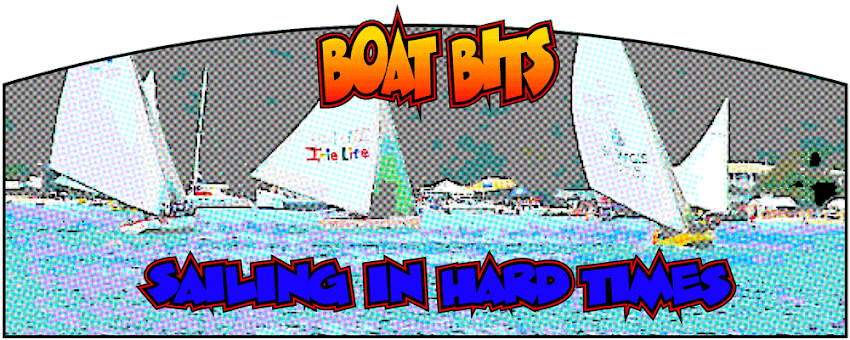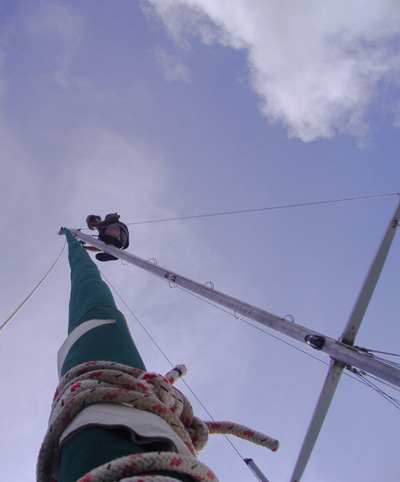On weakness, not happy making odds, and it keeps getting harder telling myself I'm from the greatest country in the world...
I used to have a square boat. Fact is, I've had a couple and there's a 50/50 chance my next boat will be square as well.
Square, when you're building stuff, can make a lot of sense.
Dave Z and I go way back... The world of folks who have built, sailed, and pushed the envelope in Bolger boats is a somewhat small world. Fact is, it's also a pretty neat world as folks who understand the late Mr Bolger's work don't always take what everybody says as gospel, tend to experiment, innovate, and regularly scandalize the neighbors.
Fun folks!
Which is an apt introduction to the TriloBoat...
So, enough of me let's talk to Dave Z!
Um... Dude... Your boat's a box?
Pretty durn close. A pure TriloBoat is a simple box barge, meaning rectangular in plan (top) view and section (end) view. The only concession to hydrodynamics are the up-curved, bottom sections towards the ends.I notice that your boats are junk rigged... is that a TriloBoat thing?
Boxes are inherently easy to build. TriloBoats are designed around the efficient use of rectangular sheet materials, and are built around a totally rectangular midsection (i.e., the long, midships area is simple, right angle joinery). Cumulative time savings are astounding, and very little material is wasted.
Just a personal choice.So tell me why the junk rig?
TriloBoats themselves are wide-open designs, with rigs, layouts and construction methods, and most details unspecified - left up to the builders. So many choices go into a boat to fit it to a particular situation that I stick to lines plans for simple hulls and superstructures. Their builders take them any direction they like from there, and generally customize their own approaches.
Anke and I choose junk rig for its simplicity, economy and quick reefing. In our home (Alaskan) waters, the ability to drop sail quickly increases our margin of safety. We can build sails cheaply and quickly in the catch-as-catch-can situations most often available to us.I've noticed you have a rather large "scallop" at the top corner of the sails... What is the thinking behind that?
The Hasler standard sail form puts a lot of sail area into the 'upper triangle'. It can be reefed, but not as easily as the rest. I once read a description of JR panels with parallel battens as being a stack of square sails, in contrast to fanned sail forms as a stack of crab claw sails. In a previous rig, we'd tried a crab claw rig, and noted that it sets and draws beautifully, and thought it would make a good form for last sail standing.
The deep scallop further reduces sail area and brings the CE inboard (reducing weather helm), prevents the leech from flogging even in high winds, and tickled our vestigial aesthetic sensibilities.
Crab claw rigs and fanned junk panels - it has been surmised - are 'turbulence generators'. Turbulent balls of air are generated near the apex and roll along the limbs (spars) creating lift. The center cloth, especially downwind, produces less drives. Many sailors of Oceania cut much deeper yet... in very high winds, the turbulent balls would detach, automatically reducing drive, and they would sail on under the small, remaining patch of sailcloth. I've always want to do a 'cartoon' hybrid junk sail as a stack of deep cut crab claws. Would look really freaky cool and might even work!Why the leeboards..., Aren't they a lot of work?
Leeboards are a fair amount of work... they only work on the lee side, and have to be raised and lowered on every (upwind) tack).Alaska is not known for it's benign conditions and some might say that having an engine-less sailboat in an area with rather extreme tides is rather foolhardy... How do you get by?
But we use retaining cables to keep them from winging out. This renders them 'off-centerboards' which work on both tacks and needn't be tended. They have all the advantages of centerboards, but are easy to maintain, never jam, require no trunks or hull apertures and each board is smaller and lighter. The guards (side planks which wing them out from the hull) make great boarding steps and make stepping off while docking a small, controlled event.
Some do say it, indeed. But without a schedule and a conservative attitude, I'd say it's safer than any reliance on engines.The TriloBoats are pretty much lumberyard materials nailed together... Stuff that anyone can get and a skill set that anyone can do. Where's the catch?
Certainly the boaters, professional and otherwise, who regularly get into serious trouble (as opposed to inconvenience) do so because their engine systems failed. Sometimes this is mechanical, and sometimes psychological (over confident and in over their heads).
The tides actually help, for the most part. They generate currents that carry us along in the absence of wind. It's pretty seldom (in our area) that they run over shoals or reefs that would endanger us, and we're on full alert in those cases. They also carry us deep into and out of shallow but well protected harbors.
But we avoid the really nasty stuff... run for shelter early, stay at anchor rather than venture into harsh conditions, choose our windows. Especially in winter, we'll move in short hops and select windows.
Even for longer, leaner box barges, once any chop has developed windward performance slows to a trudge. They're not greyhounds under any conditions, but are fast enough on a reach or run.I've noticed a lot of my readers really like the TrioBoats and several have written to tell me they have bought plans... Do I detect a rising trend?
Still, a huge amount of the world's freight was and is carried by box barge. The bean counters haven't counted them out; they pay their way in economy and quiet efficiency.
Of course, in some social circles, you need a solid sense-of-self to stand up for your vessel.
Many of this type will end up more or less stationary, and there's a fair amount of prejudice against live-aboards in general, and "houseboats" in particular (box boats are prone to be labeled as such). Freedom of the seas ain't what it used to be; freedom of any stripe, for that matter.
Well, I think so. And it's a general trend. DIY boats have always favored simplicity.You've been working on a DIY book for designing/building Trilo style boats... How is that coming?
Clear, vertical grain timbers and skilled professionals who could craft them into lovely, lissome forms are mostly reserved for the very-well-to-do.
In contrast, many of the 99% are looking to get on the water with basic skills, affordable materials and in reasonable time. Traditional forms like the sharpie, dory and barge - DIY for generations and now adaptable to sheet materials - are definitely on the rise.
Slow but steady. At this point, the text is written and I'm starting to edit. Illustrations await.What's the disadvantage/downside to a boat that's a box?
Also, there's a recent development. I just donated the TriloBoat formula to the Global Village Construction Set and their Wiki). This is going to take things in a direction difficult to predict.
I expect that I'll be completing my book (specifically aimed at individuals) - that it won't be superseded by open source development oriented toward communities.
The main one is that a box's sharp edges interrupt the smooth flow of water around the hull, slowing the boat in choppy conditions or confused seas.Where are you sailing next? Another long trip to somewhere interesting?
Many things can be done to modify this effect. Take a look, for example, at the performance of racing scows, which are some of the fastest monohulls around. In IOR monohulls we're presently seeing a possible transition from extreme Presto sharpie type hulls to extreme (albeit curvy) scow type hulls.
But making concessions to speed, one immediately starts trading away the advantages (economy, interior volume and displacement).
It sounds like we're heading toward the Stikine River Delta (near Wrangell), with SLACKTIDE, and up-river from there, to kibbitz on a documented GVCS build of a landing-craft style TriloBoat. Still working out details, but that delta is wildly beautiful, in any event.
Eventually, I'll be posting updates on our website and blog.












